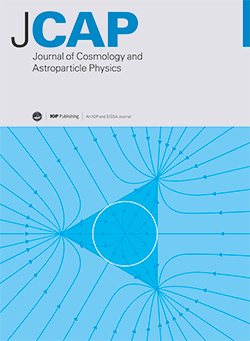来自单个超大质量黑洞双星的超低频率引力波作为标准警报
IF 5.3
2区 物理与天体物理
Q1 ASTRONOMY & ASTROPHYSICS
Journal of Cosmology and Astroparticle Physics
Pub Date : 2025-05-27
DOI:10.1088/1475-7516/2025/05/095
引用次数: 0
摘要
在未来,脉冲星定时阵列(PTAs)可能会探测到星系中心单个超大质量黑洞双星(SMBHBs)产生的超低频率引力波(GWs)。这些GW信号编码了绝对的宇宙距离,可以作为光明和黑暗的警报器,有可能演变成精确的宇宙探测器。在这里,我们展示了平方公里阵列时代的PTA,包括100毫秒脉冲星,在10年的观测期内可能会发现大约25个明亮的警报器和41个黑暗的警报器。明亮的警报器与宇宙微波背景数据相结合,为测量暗能量状态方程提供了与当前主流联合宇宙学观测相媲美的能力。“黑暗警报器”可以达到哈勃常数的测量精度,接近目前距离阶梯观测的精度。我们的研究结果表明,来自单个smbhb的超低频率GWs对于研究暗能量的性质和确定哈勃常数具有重要意义。本文章由计算机程序翻译,如有差异,请以英文原文为准。
Ultra-low-frequency gravitational waves from individual supermassive black hole binaries as standard sirens
Ultra-low-frequency gravitational waves (GWs) generated by individual inspiraling supermassive black hole binaries (SMBHBs) at the centers of galaxies may be detected by pulsar timing arrays (PTAs) in the future. These GW signals, which encode absolute cosmic distances, can serve as bright and dark sirens, potentially evolving into a precise cosmological probe. Here, we show that a PTA in the era of the Square Kilometre Array, comprising 100 millisecond pulsars, could potentially detect about 25 bright sirens and 41 dark sirens over a 10-year observation period. The bright sirens, combined with cosmic microwave background data, offer capabilities comparable to current mainstream joint cosmological observations for measuring the equation of state of dark energy. The dark sirens could achieve a measurement precision of the Hubble constant close to that of current distance-ladder observations. Our results suggest that ultra-low-frequency GWs from individual SMBHBs are of great significance in investigating the nature of dark energy and determining the Hubble constant.
求助全文
通过发布文献求助,成功后即可免费获取论文全文。
去求助
来源期刊

Journal of Cosmology and Astroparticle Physics
地学天文-天文与天体物理
CiteScore
10.20
自引率
23.40%
发文量
632
审稿时长
1 months
期刊介绍:
Journal of Cosmology and Astroparticle Physics (JCAP) encompasses theoretical, observational and experimental areas as well as computation and simulation. The journal covers the latest developments in the theory of all fundamental interactions and their cosmological implications (e.g. M-theory and cosmology, brane cosmology). JCAP''s coverage also includes topics such as formation, dynamics and clustering of galaxies, pre-galactic star formation, x-ray astronomy, radio astronomy, gravitational lensing, active galactic nuclei, intergalactic and interstellar matter.
 求助内容:
求助内容: 应助结果提醒方式:
应助结果提醒方式:


